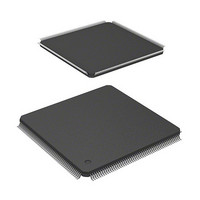HD6417705F133BV Renesas Electronics America, HD6417705F133BV Datasheet - Page 266

HD6417705F133BV
Manufacturer Part Number
HD6417705F133BV
Description
MPU 3V 0K PB-FREE 208 FP
Manufacturer
Renesas Electronics America
Series
SuperH® SH7700r
Datasheet
1.HD6417705F133BV.pdf
(741 pages)
Specifications of HD6417705F133BV
Core Processor
SH-3
Core Size
32-Bit
Speed
133MHz
Connectivity
EBI/EMI, FIFO, IrDA, SCI, USB
Peripherals
DMA, POR, PWM, WDT
Number Of I /o
105
Program Memory Type
ROMless
Ram Size
32K x 8
Voltage - Supply (vcc/vdd)
1.4 V ~ 1.6 V
Data Converters
A/D 4x10b
Oscillator Type
Internal
Operating Temperature
-20°C ~ 75°C
Package / Case
208-LQFP
Lead Free Status / RoHS Status
Lead free / RoHS Compliant
Eeprom Size
-
Program Memory Size
-
- Current page: 266 of 741
- Download datasheet (5Mb)
7.8.7
Bank Active
The synchronous DRAM bank function is used to support high-speed accesses to the same row
address. When the BACTV bit in SDCR is 1, accesses are performed using commands (READ,
WRIT) without auto-precharge. This function is called bank-active function. This function is valid
only for either the upper or lower bits of area 3. When area 3 is set to bank-active mode, area 2
should be set to normal space or byte-selection SRAM. When areas 2 and 3 are both set to
SDRAM or both the upper and lower bits of area 3 are connected to SDRAM, auto pre-charge
mode must be set. In this case, precharging is not performed when the access ends. When
accessing the same row address in the same bank, it is possible to issue the READ or WRIT
command immediately, without issuing an ACTV command. As synchronous DRAM is internally
divided into several banks, it is possible to activate one row address in each bank. If the next
access is to a different row address, a PRE command is first issued to precharge the relevant bank,
then when precharging is completed, the access is performed by issuing an ACTV command
followed by a READ or WRIT command. If this is followed by an access to a different row
address, the access time will be longer because of the precharging performed after the access
request is issued.
In a write, when auto-precharge is performed, a command cannot be issued for a period of Trwl +
Tpc cycles after issuance of the WRITA command. When bank active mode is used, READ or
WRIT commands can be issued successively if the row address is the same. The number of cycles
can thus be reduced by Trwl + Tpc cycles for each write.
There is a limit on t
, the time for placing each bank in the active state. If there is no guarantee
RAS
that there will not be a cache hit and another row address will be accessed within the period in
which this value is maintained by program execution, it is necessary to set auto-refresh and set the
refresh cycle to no more than the maximum value of t
.
RAS
A burst read cycle without auto-precharge is shown in figure 7.20, a burst read cycle for the same
row address in figure 7.21, and a burst read cycle for different row addresses in figure 7.22.
Similarly, a burst write cycle without auto-precharge is shown in figure 7.23, a single write cycle
for the same row address in figure 7.24, and a single write cycle for different row addresses in
figure 7.25.
When bank active mode is set, if only accesses to the respective banks in the area 3 space are
considered, as long as accesses to the same row address continue, the operation starts with the
cycle in figure 7.20 or 7.23, followed by repetition of the cycle in figure 7.21 or 7.24. An access to
a different area during this time has no effect. If there is an access to a different row address in the
bank active state, after this is detected the bus cycle in figure 7.22 or 7.25 is executed instead of
that in figure 7.21 or 7.24. In bank active mode, too, all banks become inactive after a refresh
cycle or after the bus is released as the result of bus arbitration.
Rev. 2.00, 09/03, page 218 of 690
Related parts for HD6417705F133BV
Image
Part Number
Description
Manufacturer
Datasheet
Request
R

Part Number:
Description:
KIT STARTER FOR M16C/29
Manufacturer:
Renesas Electronics America
Datasheet:

Part Number:
Description:
KIT STARTER FOR R8C/2D
Manufacturer:
Renesas Electronics America
Datasheet:

Part Number:
Description:
R0K33062P STARTER KIT
Manufacturer:
Renesas Electronics America
Datasheet:

Part Number:
Description:
KIT STARTER FOR R8C/23 E8A
Manufacturer:
Renesas Electronics America
Datasheet:

Part Number:
Description:
KIT STARTER FOR R8C/25
Manufacturer:
Renesas Electronics America
Datasheet:

Part Number:
Description:
KIT STARTER H8S2456 SHARPE DSPLY
Manufacturer:
Renesas Electronics America
Datasheet:

Part Number:
Description:
KIT STARTER FOR R8C38C
Manufacturer:
Renesas Electronics America
Datasheet:

Part Number:
Description:
KIT STARTER FOR R8C35C
Manufacturer:
Renesas Electronics America
Datasheet:

Part Number:
Description:
KIT STARTER FOR R8CL3AC+LCD APPS
Manufacturer:
Renesas Electronics America
Datasheet:

Part Number:
Description:
KIT STARTER FOR RX610
Manufacturer:
Renesas Electronics America
Datasheet:

Part Number:
Description:
KIT STARTER FOR R32C/118
Manufacturer:
Renesas Electronics America
Datasheet:

Part Number:
Description:
KIT DEV RSK-R8C/26-29
Manufacturer:
Renesas Electronics America
Datasheet:

Part Number:
Description:
KIT STARTER FOR SH7124
Manufacturer:
Renesas Electronics America
Datasheet:

Part Number:
Description:
KIT STARTER FOR H8SX/1622
Manufacturer:
Renesas Electronics America
Datasheet:

Part Number:
Description:
KIT DEV FOR SH7203
Manufacturer:
Renesas Electronics America
Datasheet:










